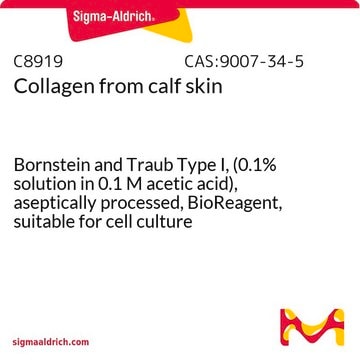C3511
Collagen from calf skin
Bornstein and Traub Type I (Sigma Type III), solid
Sign Into View Organizational & Contract Pricing
All Photos(2)
About This Item
Recommended Products
biological source
bovine (calf) skin
form
solid
technique(s)
cell culture | mammalian: suitable
solubility
aqueous acid: soluble
suitability
suitable for substrate for collagenase
UniProt accession no.
storage temp.
2-8°C
Gene Information
bovine ... COL1A1(282187)
Looking for similar products? Visit Product Comparison Guide
Application
This product is intended to produce thin layer coatings on tissue culture plates to facilitate attachment of anchorage-dependent cells, recommended for use at 6-10 μg/cm2. It is NOT intended for production of 3-D gels. Type I collagen is often used in cell culture as an attachment substratum with myoblasts, spinal ganglia, hepatocytes, embryonic lung, heart explants, fibroblasts, endothelial cells, and islet cells have all been cultured successfully on films or gels of type I collagen. Collagen type I may also be used in research of Idiopathic pulmonary fibrosis (IPF), studies on the effect of ER stress IPF on lung fibroblasts. Collagen in acidic solution can produce three dimensional scaffolding with use in bioengineering and cell culture applications.
Biochem/physiol Actions
Type I collagen is a component of skin, bone, tendon, and other fibrous connective tissues.
Components
All collagen molecules are composed of three polypeptide chains arranged in a triple helical conformation, with a primary structure that is mostly a repeating motif with glycine in every third position and proline or 4-hydroxyproline frequently preceding the glycine residue. Type I collagen differs from other collagens by its low lysine hydroxylation and low carbohydrate composition.
Preparation Note
Prepared by a modification of the method of Gallop, P.M., and Seifter, S., Meth. Enzymol., VI, 635 (1963).
Other Notes
Collagen is classified into a number of structurally and genetically distinct types. We use the nomenclature proposed by Bornstein and Traub. Do not confuse Sigma type designations with recognized collagen classification types.
Storage Class Code
11 - Combustible Solids
WGK
WGK 1
Flash Point(F)
Not applicable
Flash Point(C)
Not applicable
Personal Protective Equipment
dust mask type N95 (US), Eyeshields, Gloves
Certificates of Analysis (COA)
Search for Certificates of Analysis (COA) by entering the products Lot/Batch Number. Lot and Batch Numbers can be found on a product’s label following the words ‘Lot’ or ‘Batch’.
Already Own This Product?
Find documentation for the products that you have recently purchased in the Document Library.
In vitro and in vivo models for evaluation of GDEPT: quantifying bystander killing in cell cultures and tumors.
William R Wilson et al.
Methods in molecular medicine, 90, 403-431 (2003-12-06)
K Bittner et al.
The Biochemical journal, 314 ( Pt 1), 159-166 (1996-02-15)
The small dermatan sulphate protein decorin interacts via its core protein with fibrillar collagens, and its glycosaminoglycan chains were proposed to be capable of self-association. It was therefore of interest to study the role of decorin in the contraction of
Qiyin Fang et al.
The Review of scientific instruments, 75(1), 151-162 (2004-01-01)
We report the design and development of a compact optical fiber-based apparatus for in situ time-resolved laser-induced fluorescence spectroscopy (tr-LIFS) of biological systems. The apparatus is modular, optically robust, and compatible with the clinical environment. It incorporates a dual output
Zhongcheng Gong et al.
Biomedical materials (Bristol, England), 5(5), 055005-055005 (2010-09-10)
The objective was to investigate synovium-derived stromal cells (SDSCs) coupled with chitosan/collagen type I (CS/COL-I) scaffolds for cartilage engineering. CS/COL-I scaffolds were fabricated through freeze-drying and cross-linked by 1-ethyl-3-(3-dimethylaminopropyl)carbodiimide. SDSCs were isolated from synovium and cultured onto CS/COL-I scaffolds, constructs
S Teixeira et al.
Journal of biomedical materials research. Part A, 95(1), 1-8 (2010-08-27)
This study concerns the preparation and in vitro characterization of functionalized hydroxyapatite (HA) porous scaffolds, which are intended to be used as drug-delivery systems and bone-regeneration matrices. Hydroxyapatite scaffolds were prepared using the polymer replication method, and, after being submitted
Our team of scientists has experience in all areas of research including Life Science, Material Science, Chemical Synthesis, Chromatography, Analytical and many others.
Contact Technical Service








